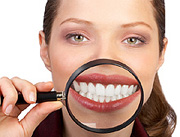Tooth Whitening A 2 Z

There are so many quotes surrounding smiles. Some of the more common ones include "if you smile at someone, they might smile back" and "everyone smiles in the same language" — but if your smile is stained and yellow, you may not want to put on your happy face.
In our high pressure society, where appearance and looking good is everything, cosmetic dentistry and tooth whitening is an emerging market. A sparkling smile makes a huge difference to your appearance, but can also influence your quality of life. If your teeth are stained and yellow, you may not feel comfortable smiling and limit yourself from living life.
The phenomenon of tooth whitening has become big business. Not just for celebs in Hollywood, but for everyone who cares about their appearance. Very few people have naturally brilliant white teeth, and even if they have, it is common for teeth to lose their 'whiteness' as we get older. Food and drink, specifically red wine, coffee and tea, as well as cigarette smoking, all contribute to discoloured teeth. Teeth can also lose their brightness due to under the surface staining, which may be caused by cracks in the teeth as well as certain antibiotics.
There are various ways you can go about whitening your teeth. It can be done professionally by your dentist or via one of the home whitening systems or kits. The option you ultimately choose depends on your budget and the degree of staining on your teeth.
Professional Tooth Whitening
While this process is very expensive, the costs may seem minimal when your smile is putting a hamper on your quality of life. The professional system takes about one hour and is generally done at your dentist's office.
The nice thing about this system is that you are putting your smile in the hands of a qualified professional, who knows teeth. The process at your dentist begins with a minor polish to remove any plaque that may be sitting on the gum line and is followed by the application of a peroxide based gel. This gel is then activated using a special light.
It is important to note that tooth whitening may not be successful after the first application, and may only start to show effect after a few applications. Consulting with your dentist will help you identify if this process is right for you.
Whitening Toothpastes and Gels
Many toothpaste companies, including Mentadent P and Colgate have formulated special toothpastes that help to whiten teeth. Some toothpaste companies may only specialise in whitening toothpastes. These toothpastes may be effective for you, but the outcome depends on the type of staining on your teeth as well as the degree of the stains.
Toothpastes with "whitening" properties rely on abrasion in order to remove the stains, and may be effective for minor discoloured surface stains. If your teeth are very yellow, this treatment many not be effective for you.
Over-the-Counter Bleaching Kits
If you can't afford to go to a professional dentist, consider an over the counter bleaching treatment. Although this system has been shown to get results, cases of whitened gums and irritation have occurred, making it risky business.
If you do decide to go with this type of whitening system, consult with your dentist on his or her recommendations before you make a purchase.
Prevention Is Better Than Cure
Taking care of your teeth is vital if you want a bright smile. And there are numerous things you can do in your daily life that will aid in the prevention of further discolouring your teeth.
- Brush your teeth at least twice a day using a whitening toothpaste. The best times to brush are after you've had breakfast in the morning and just before you go to bed.
- Avoid drinking too much tea, coffee and red wine whenever possible. These drinks only add to the discolouration of your teeth.
- Quit smoking. It's not only hazardous to your health and those around you, but to your teeth as well.
- Don't forget to floss. Flossing helps to remove plaque build up between the teeth and can also help to prevent under the surface stains. Flossing also helps to prevent decay between the teeth — a common place for it to form.
Author: Dimi Ingle
Copyright: Remedium. This article may not be copied, in whole or in part, without the written consent of Remedium.
|